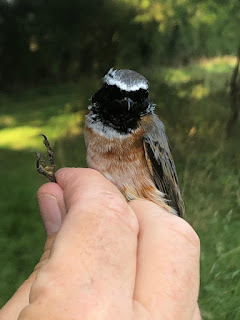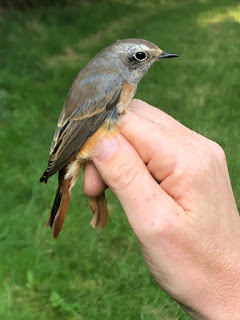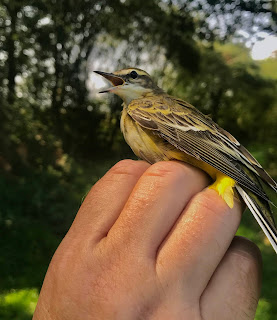There
are now lots of juvenile birds around, so we have to get out and ring
them! The weather had been either windy or wet, or both, so we
weren’t sure if there would be much about, however as it transpired
we didn’t need to have worried.
Mick,
Adam, Dave, Kate and I met up on Saturday 15th June at the railtrack
at 0430, plus Sam, who is interested in learning how to ring. For the
CES, we put up a minimum of 14 nets (plus sundry others at the
feeders), so it is quite labour intensive. We got them up nice and
quickly on a cool, still morning and Dave and Adam then went off to
attend to the local nest boxes we have scattered through the woods
surrounding the reservoir.
After
a well deserved cup of tea, we started the first round. There was no
shortage of birds! We had 50 birds on the first round and almost as
many on the second. It was nice to see that there were plenty of
juveniles around. Unavoidably, there were many juvenile tits, but
also good numbers of migratory warblers. It looks like Whitethroat,
Blackcap and Chiffchaff are going to have a good year, as too are our
resident Tree sparrows. However there were some notable absentees,
including Grasshopper and Cetti’s warblers. We are a bit concerned
that the former, although reeling early in the year, haven’t bred,
although it is likely that the latter have - up at the Point.
Anyway,
we worked quite hard with Mick scribing and Kate and I ringing in a
stalwart fashion, while Sam handed us the bird bags and probably
wondered what he had got himself into. At the end of the day we had
111 new birds ringed and 76 retraps processed. Just 13 short of the
double ton! Standout birds were one juvenile Willow tit and a
juvenile Kingfisher. This is our second Kingfisher this year, which
is reassuring- they had a horrible year in 2018 due to the blizzards
from the east last year, so we are delighted they are breeding again.
Dave
and Adam carried out a nest box check and ringed two adult and two pulli Stock Doves, 8 Swallow pulli and 9 Tree Sparrow pulli, plus 3 Barn Owl nestlings, courtesy of Park
Farm.
After
all this work, we could barely manage to lift our glasses in the
White Hart, but I’m glad to report we managed some fluid
resuscitation before heading home.
Peter
N



